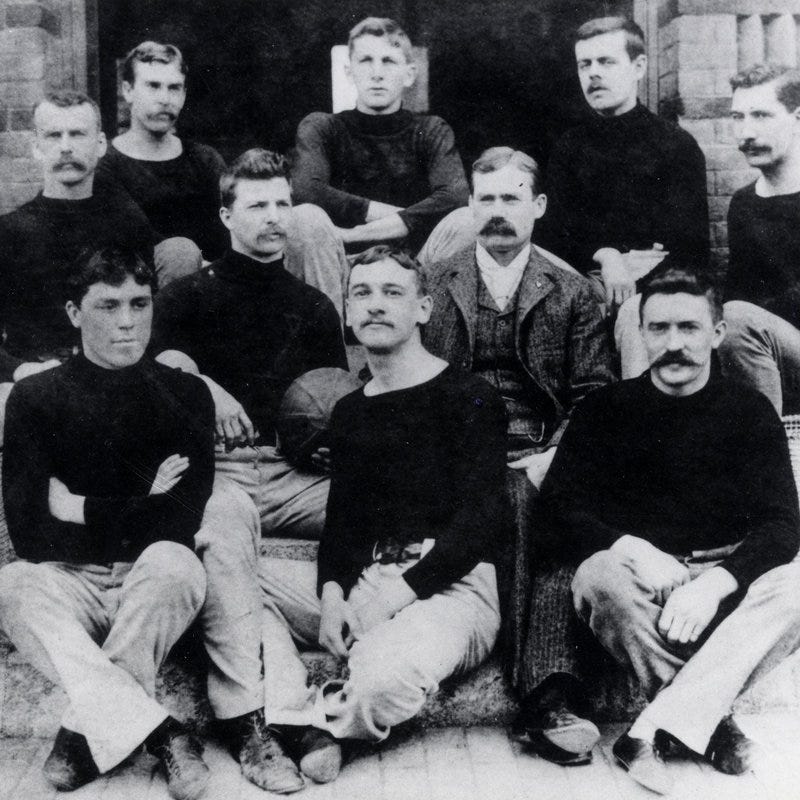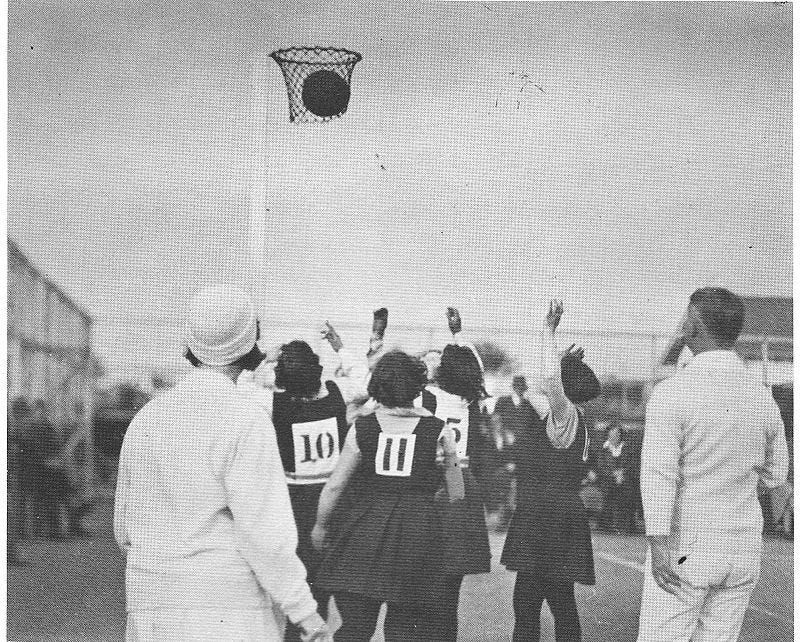In the beginning, basketball was a pretty ridiculous sport.
You can thank James Naismith for bringing us the absurdity of people throwing a ball into a wall-mounted peach basket. A motley mix of inspiration, caution, and creativity derived from other sports led Naismith toward this quirky idea. But the silliness enthralled Naismith’s malcontent class at the YMCA Training School in December 1891.
As all stressed out school teachers know, by Christmas break you’re just ready to be done with an unruly class. Naismith wasn’t much different. He breathed a sigh of relief that after weeks of failed attempts, he finally made an indoor sport the class liked.
Shortly afterwards in January 1892, Naismith publicly announced his new game in The Triangle, a physical education magazine edited by Naismith and Luther Gulick at the YMCA Training School based in Springfield, Massachusetts.
In the article, Naismith talks up the many positive aspects of “basket ball” including that everyone on the court “get[s] plenty of exercise” and that it “combines skill with courage and agility so that the better team wins.”
Some of the principles and 13 rules Naismith laid out are shockingly familiar, if not outright identical to how things still stand today.

(Naismith with some of his unruly students, the first players of basketball)
The Identical:
“The object of the game is to put the ball into your opponents’ goal.”
“The ball may be thrown in any direction with one or both hands.”
Teams had five seconds to inbound the basketball from out of bounds.
The Familiar:
Fouls were called for “shouldering, holding, pushing, tripping, or striking,” but the punishment was wildly different. The first infraction only resulted in a warning. A player guilty of a second foul would be disqualified from the game until one of the two teams scored a field goal.
Fouls were not limited to physical violence and incorporated what we now just think of as violations. “[S]triking at the ball with the fist,” running with the ball (traveling), and using your body or arms to hold the ball also counted as “fouls.”
Game divided into two halves, albeit 15 minutes each.

(The first illustration depicting basketball)
But some of the rules and principles were insane given nearly 130 years of changes, trials, and errors.
For starters, there was no basketball because the sport had just been invented. Instead, the ball used to play basketball was an “ordinary Association foot ball.” Fancy way of saying they used a soccer ball.
Oh and Naismith said team sizes “may range from three on a side to forty.” 40! Ford-E! Four-Zero! Just, wow.
Okay, he wasn’t totally insane. Naismith did encourage nine-man teams and devised these positions for the game.
Goalkeeper and Two Guards to “prevent the opponents from scoring.”
Three Centers who “shall feed the ball forward to the man who has the best opportunity” to score.
Two Wings and Home Man “to put the ball into the opponents’ goal.”
To the dismay of Kyrie Irving, players had to pass the ball to advance it. No dribbles allowed.
Lastly, there’s this really foreign concept concerning fouls:
Free throws after a foul were considered, “but, after a little practice, a good thrower could convert it into a goal almost every time[.]” Instead, if a team committed three consecutive fouls, the opponent received an automatic field goal. Naismith claimed that “when a team finds that another foul would count a goal against them, the extra foul is hardly ever made, showing that it is possible to play the game without making fouls.”
Obviously, over the decades, things have been changed.
Free throws quickly replaced Naismith’s three-foul rule.
Dribbling, something which Naismith hadn’t conceived of, but was delighted by when it was improvised by players, was hotly debated. The men’s game largely accepted it by the 1910s, but many variations of women’s basketball didn’t allow it until the mid-20th century.
The nine-man squads inspired by soccer and advocated by Naismith were squeezed down to five. The evolution of guards, forwards and centers remains a topic for later discussion in this here newsletter.
The basket is still 10 feet high, but our vestigial vocabulary still refers to it as a “basket” even though it is anything but. Imagine going to a grocery store and finding only “baskets” composed of metal rings with open nets incapable of storing anything?
Yeah, not a basket. But it’d feel wrong to call this sport of ours Iron Rim Ball or, heaven forbid, Net Ball. Oh wait, that’s actually a thing…

ANYWAYS! So that’s a glimpse at some of the craziness found in basketball’s first rules.
Next Sunday, I’ll be conversatin’ with Paul Putz, a friend of the program. Paul’s a professor at Baylor University exploring the relationship between Christianity and sports.
What’s Jesus have to do with basketball? More than you think!
It’s no accident basketball started at the Young Men’s Christian Association.
Until next time…
Image credits:
- James Naismith and some of his students at the YMCA Training School in 1892, Kautz Family YMCA Archives, University of Minnesota Libraries
- “Basket Ball”, James Naismith, The Triangle, January 15, 1892
- Netball in New Zealand c. 1920, Wikimedia, Public Domain
BASKETBALL’S JUST BEGUN!
Unsolved ProHoopsMysteries
If basketball started at a YMCA, where did pro hoops come from?
When was the first actual basketball made?
Exactly when did people decide free throws were indeed a better method than Naismith’s idea for punishing fouls?
For a sport - like many others - belittled as "a kid’s game,” the first players of basketball sure were old. What’s up with that?



Great start Curtis. So happy you decided to do this and more than happy to show my support!